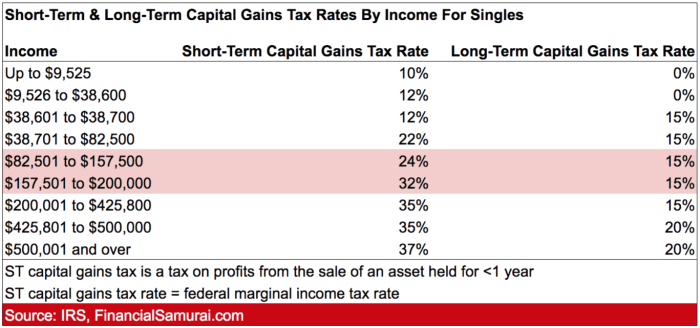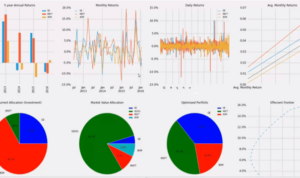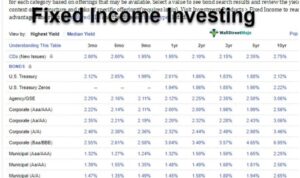Capital gains tax rates set the stage for this enthralling narrative, offering readers a glimpse into a story that is rich in detail and brimming with originality from the outset. Dive into the world of finance with us as we explore the ins and outs of capital gains tax rates.
From understanding the basics to exploring the intricate details, this guide will equip you with the knowledge needed to navigate the complexities of capital gains tax rates like a pro.
Overview of Capital Gains Tax Rates

Capital gains tax rates refer to the tax imposed on the profits earned from the sale of assets such as stocks, real estate, or other investments. This type of tax is different from other taxes like income tax because it specifically targets the increase in value of investments.
Understanding capital gains tax rates is crucial for individuals and businesses as it affects their investment decisions and overall financial planning. By knowing how much tax they will owe on their capital gains, investors can better assess the risk and potential returns of different investment opportunities.
Importance of Understanding Capital Gains Tax Rates
- Capital gains tax rates can influence the timing of selling an asset to maximize profits.
- Knowing the tax implications can help investors choose between short-term and long-term investments.
- Understanding capital gains tax rates is essential for proper tax planning and compliance with regulations.
Types of Capital Gains Tax Rates
Capital gains tax rates can vary depending on the type of asset sold and how long it was held. Let’s explore the key differences between short-term and long-term capital gains tax rates, as well as how different assets are taxed and any special considerations that may apply.
Short-term vs. Long-term Capital Gains Tax Rates
Short-term capital gains tax rates are applied to assets held for one year or less before being sold. These gains are typically taxed at the individual’s ordinary income tax rate, which can range from 10% to 37% based on income level.
On the other hand, long-term capital gains tax rates are for assets held for more than one year before being sold. These rates are usually lower than short-term rates, with most taxpayers paying either 0%, 15%, or 20% depending on their income bracket.
Taxation of Different Assets
Different assets are taxed at varying capital gains tax rates. For example, stocks, bonds, and real estate are typically subject to capital gains tax when sold for a profit. However, certain assets like collectibles and precious metals may have different tax rates or treatment.
Additionally, some assets may qualify for preferential treatment under the tax code, such as qualified small business stock or investments in Opportunity Zones. These special considerations can result in lower capital gains tax rates or even exemptions for certain types of investments.
Special Considerations and Exemptions
Certain types of capital gains may be eligible for special considerations or exemptions. For instance, homeowners may be able to exclude up to $250,000 ($500,000 for married couples) of capital gains on the sale of their primary residence if certain criteria are met.
Similarly, investments in qualified retirement accounts like 401(k)s or IRAs are generally not subject to capital gains tax until funds are withdrawn. This can provide a tax-advantaged way to grow investments over time without immediate tax consequences.
Factors Influencing Capital Gains Tax Rates
When it comes to capital gains tax rates, there are several factors that can influence how they are determined. These factors can range from economic conditions to government policies and regulations, as well as the impact of inflation over time.
Economic Factors
Economic factors play a crucial role in determining capital gains tax rates. For example, during times of economic growth, governments may decide to increase these rates to generate more revenue. On the other hand, during economic downturns, lowering capital gains tax rates could stimulate investment and economic activity.
Government Policies and Regulations
Government policies and regulations also have a significant impact on capital gains tax rates. Changes in tax laws, such as the Tax Cuts and Jobs Act of 2017 in the U.S., can lead to alterations in how capital gains are taxed. Additionally, political decisions and priorities can influence whether tax rates are adjusted upward or downward.
Inflation Adjustment
Inflation plays a crucial role in adjusting capital gains tax rates over time. Since capital gains are calculated based on the difference between the purchase price and the selling price of an asset, inflation can erode the real value of these gains. As a result, tax authorities may adjust tax rates to account for inflation and ensure that taxpayers are not overburdened by taxes on gains that do not reflect true economic growth.
Strategies to Minimize Capital Gains Tax
When it comes to minimizing capital gains tax, there are several tax-efficient investment strategies that can help reduce your tax liabilities. One common strategy is tax-loss harvesting, which involves selling investments at a loss to offset capital gains and reduce taxable income. Additionally, utilizing tax-deferred accounts can also play a key role in managing capital gains tax by allowing you to defer taxes on investment gains until a later date.
Tax-Loss Harvesting
Tax-loss harvesting is a strategy where you sell investments that have experienced a loss to offset capital gains realized from other investments. By realizing losses, you can reduce your taxable income and potentially lower your overall tax liability. For example, if you have $5,000 in capital gains but also $3,000 in capital losses, you can offset the gains with the losses, resulting in only $2,000 being taxed.
Tax-Deferred Accounts
Tax-deferred accounts, such as Traditional IRAs and 401(k) plans, allow you to invest pre-tax dollars and defer taxes on investment gains until you start making withdrawals in retirement. By utilizing these accounts, you can grow your investments tax-free and potentially reduce your current tax burden. For instance, if you contribute $5,000 to a Traditional IRA, that $5,000 is deducted from your taxable income for the year, reducing your overall tax liability.






